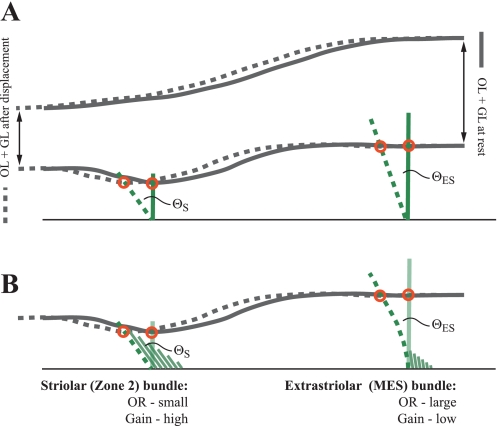Fig. 9.
Effects of kinocilium height (A) and KS ratio (B) in vivo on a striolar bundle (S, left) and a bundle from the MES (ES, right). Dark gray lines represent the otoconial membrane (OM), from the top of the otoconial layer to the bottom of the gel layer. Relative dimensions of the OM in the striola and MES are approximated from Xue and Peterson (2003). Kinocilia attach at the bottom of the gel layer (red circles). Accelerations generated by head movement are converted to a proportional displacement of the OM and kinocilia from their start position (solid lines) to a new position (dashed lines). This produces an angular rotation of hair bundles (Θ), the size of which depends on the height of the applied force (A, i.e., kinocilium height) and KS ratio (B). In this model, we assume that bundle resistance to deflection produces no deformation of the OM. A: a unit displacement of the OM (distance between red circles for each bundle) generates a greater angular rotation of the striolar bundle than the extrastriolar bundle because the kinocilium is shorter: ΘS > ΘES. This yields a greater transduction current in the striolar bundle per unit displacement, i.e., its current/bundle displacement (I/X) gain (sensitivity) is greater than that of the extrastriolar bundle and consequently its operating range (OR) is relatively small. Stereocilia are omitted for clarity. B: the hair bundles in A are depicted with rigid kinocilia, and so the angular rotation produced by a unit tip displacement of the kinocilium depends on bundle geometry alone (i.e., kinocilium height). But real kinocilia can bend and shear when deflected (Spoon and Grant 2011), and kinocilia on bundles with high KS ratios will bend because they are not buttressed by their short stereocilia (right). This yields a smaller angular rotation of the bundle (ΘES) in response to a unit displacement (compared with the rigid kinocilium condition depicted in A, i.e., ΘES in A is greater than ΘES in B) because deflection of the kinocilium tip is not efficiently relayed to the ciliary insertions at the bundle base. Thus high KS ratios combined with compliant kinocilia further decrease the gain and increase the OR of extrastriola bundles. For clarity, only the bottom layer of the OM is depicted in B, and bundles at rest are represented by the kinocilium only. Note that the features that contribute to high bundle stiffness under experimental conditions (short kinocilia and low KS ratios) also help shape the sensitivity (I/X gain) and OR of hair cells in vivo. In this example, we depict the 2 extremes of bundle stiffness (striolar zone 2 and the MES). In real utricles, a gradient of kinocilium heights and KS ratios provides the broad spectrum of hair cell gains and ORs necessary to transduce the full complement of accelerations produced during natural head movements. OL, otoconial layer; GL, gel layer.

